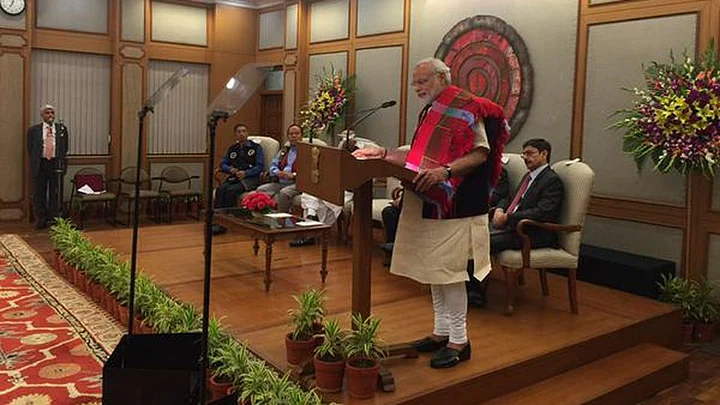What the Naga Peace Accord Means
- The insurgent outfit’s cadres who surrender will form two army and four paramilitary force battalions.
- There are niggling doubts about how the accord might impact the Kuki tribes who cohabit with the Nagas in Manipur’s hill districts and the NSCN(K).
- The Centre and the NSCN(IM) closed the deal four months after the NSCN(Khaplang) group abrogated a 14-year-old ceasefire with the government.
- A key element of the peace agreement is the introduction of a restricted area permit as a means to protect the Nagas’ identity and to restrict ‘outsiders’ from settling in Nagaland and other states with substantial Naga presence.
One of the many key terms of the agreement signed between the Narendra Modi government and the National Socialist Council of Nagaland (Isak-Muivah) is that the insurgent outfit’s cadres who surrender, once the so-called “historic” peace accord with the Centre comes into effect, will form two army and four paramilitary force battalions.
While the accord is being hailed as a major step towards initiating peace in the northeast, there are niggling doubts about its longevity considering the fact that it was inked without considering the implications of how it might impact the Kuki tribes who cohabit with the Nagas in Manipur’s hill districts and the NSCN(K).
Factionalism and Difference of Opinion
The Centre and the NSCN(IM) closed the deal four months after the NSCN(Khaplang) group abrogated a 14-year-old ceasefire with the government before launching a series of attacks against the security forces in Nagaland and Manipur. Around that time, the NSCN(K) itself split with two senior functionaries Y Wangtin Naga and P Thikak breaking away to form the NSCN(Reformation) which reposed its faith in a dialogue with the government.
The peace accord will now be viewed with suspicion by the NSCN(R) as a settlement between the government and the NSCN(IM). Indeed, some northeast observers say that Muivah may even have applied pressure on the Centre to come up with an accord sans the details. Besides, there are differences of opinion between the NSCN(IM) and yet another Naga group led by Khole Konyak and Khitovi Zimomi who broke away from the NSCN(K) to form the NSCN(Khole-Khitovi) in June 2011.
What is, however, certain is that the signing of the accord on August 3 was a “rush job” keeping in view the NSCN(IM) leadership’s concern over the deteriorating health of outfit Chairman Isak Chisi Swu who remains admitted at Fortis hospital in Delhi. Swu was insistent that he sign on the document with NSCN(IM) General Secretary Thuingaleng Muivah.
Disarmament Tactics
While disarming of several thousand NSCN(IM) will undoubtedly take months, the key concern of the rebel organisation’s leaders was the establishment of six battalions composing surrendered cadres. This is among the 33-point accord which centres around the most crucial aspect of some form of autonomy for Nagaland and other Naga-inhabited areas in Manipur, Arunachal Pradesh and Assam.
Suffice to say that after the 1975 Shillong Accord, parts of which could not be implemented, the ‘Great Naga’ 111 BSF Battalion, comprising members of the erstwhile Naga rebel group, was formed with headquarters in Satakha in Zunheboto district of Nagaland.
The government’s interlocutor and the NSCN(IM) leadership, who met 80 times over an 18-year period to thrash out the details of the accord, agreed to skirt around the contentious and potentially volatile issue of integration of Naga-inhabited areas in Manipur, Arunchal Pradesh and Assam.
However, the Centre has sought to accommodate the NSCN(IM)’s wishes of recognising the ‘unique history’ of the Nagas, which is one of way of working out a formula that would involve greater devolution of powers, including special status, for Nagaland and the other three states with sizeable population of Nagas.
Recognising the ‘unique history’ of the Nagas could also mean expanding the political influence of the Nagas in Manipur. This could take the shape of increasing the number of seats in the Manipur assembly which at present has 60 members. In other words, there could be a delimitation of the constituencies in Manipur’s hill districts which are home to about 3 lakh Nagas of various tribes.
Outsiders Not Allowed
Another key element of the peace agreement is introduction of a restricted area permit, on the lines of the inner line permit in other northeastern state, as a means to protect the Nagas’ identity. This proposal envisages restricting ‘outsiders’ from the other parts of India to settle in Nagaland and other states with substantial Naga presence.
Both the NSCN(IM) and the government have described the accord as a ‘framework agreement’ which is being interpreted as an accord that has the limited objective of framing the agreed-upon terms between the two parties. Several easily resolved, non-contentious issues form part of the framework agreement.
On Monday, the Narendra Modi government had signed a historic peace pact with the Naga outfit named after its leaders, Isak Chishi Swu and Thuingaleng Muivah.
(At The Quint, we question everything. Play an active role in shaping our journalism by becoming a member today.)
